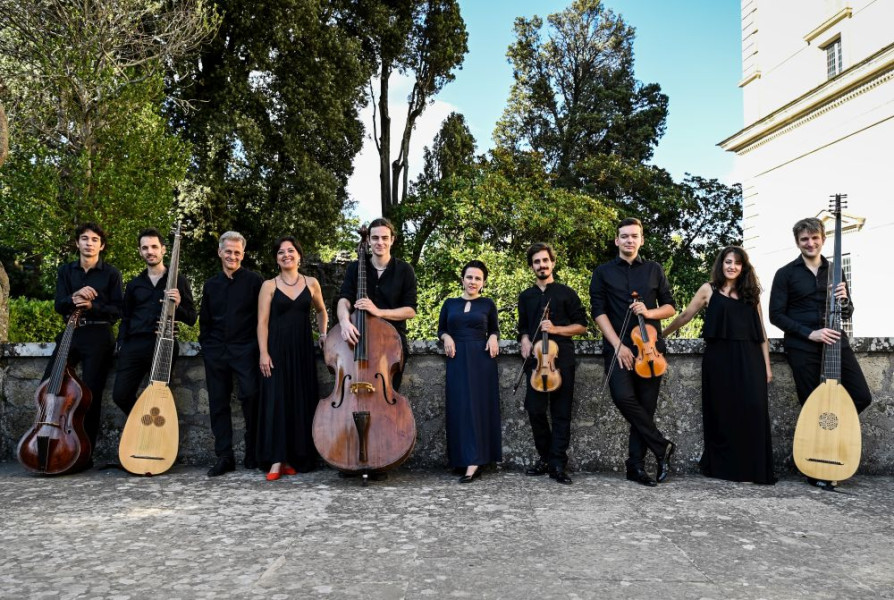From Music to Understanding
The Mare Nostrum Ensemble performed at the Church of Our Lady in Prčanj on Friday, July 14, playing on historical instruments or replicas of instruments that were used during the Baroque period.
Following the world music and the exploration of popular and traditional music through the lens of violinist Nemanja Radulović at the opening of KotorArt, the festival program delved deeply into the 17th century. The Mare Nostrum Ensemble performed at the Church of Our Lady in Prčanj on Friday, July 14, playing on historical instruments or replicas of instruments that were used during the Baroque period.
Guided by maestro Andrea De Carlo, Mare Nostrum (a term employed by Romans for the Mediterranean) has, over nearly two decades, established itself as an esteemed ensemble specializing in the interpretation of early music, with a focus on Italian Baroque. Given the heterogeneity of Baroque practices, the ensemble is particularly dedicated to the Roman school by nurturing the works of Roman masters, most notably those by Alessandro Stradella.
In addition to their selection from Stradella’s vocal-instrumental repertoire, the Mare Nostrum Ensemble performed compositions by Giovanni Legrenzi, Francesco Cavalli, and Antonio Vivaldi. Despite Stradella’s lack of direct acquaintance with these three composers, the Ensemble’s conductor, Andrea De Carlo, skillfully constructed a bridge that allowed us to perceive a spiritual connection between Stradella and these luminaries within the Venetian backdrop. Venice was one of the most developed centers for Baroque opera during that era. Stradella, whose life tragically ended in Genoa, sought refuge from his native Rome in Venice, propelled by affairs of love and finance. During his several months in the city, he crossed paths with the works of Francesco Cavalli and completed two of his unfinished operas – Scipione affricano and Giasone. At the same time, composer Giovanni Legrenzi was presenting his operas in Venice, and just a few months after Stradella’s departure from the city in 1678, the illustrious Antonio Vivaldi was born. Venice thus became the crossroads of a spiritual dialogue, uniting Stradella on one side and Cavalli, Legrenzi, and Vivaldi on the other.
The compositions of these composers were performed at KotorArt by the six-member Mare Nostrum Ensemble: violinists Gabriele Toscani and Marco Kerschbaumer, theorbist Ulrik Gaston Larsen, cellist Tomas Chigioni, double bassist Amleto Matteucci, harpsichordist Lucia Adelaide Di Nicola, and soprano Giulia Bolcato. Concerning Stradella’s compositions, the artists presented selections from the oratorio La Susanna – an overture and an aria from the musical drama Scipione affricano, from the cantata Lasciate ch’io respiri, and from the opera Le gare dell’ amor eroico. In succession, the audience had the opportunity to listen to pieces from the opera La divisione del mondo by Giovanni Legrenzi and Artemisia by Francesco Cavalli, as well as Antonio Vivaldi’s Follia. Clearly, this succession of musical works by different authors illuminated Stradella's musical legacy in a positive light. Moreover, the ensemble, through impeccable in tune interpretation, harmonious synchronization of instruments, and adherence to the norms of Baroque performance practice, showcased that Stradella's opus harmonizes seamlessly with the aesthetics of the Italian Baroque’s grand maestros.
The Mare Nostrum Ensemble’s performance was met with ovations, with soprano Giulia Bolcato leaving an indelible impression. Through her vocal prowess, she masterfully highlighted the dichotomies inherent in Baroque music: opulent arias counterbalanced by poignant recitatives, and virtuosic displays juxtaposed with serene cantilenas, heightening or soothing contrasts as dictated by the contours of the musical score.
Boris Marković
Izvor: www.vijesti.me

